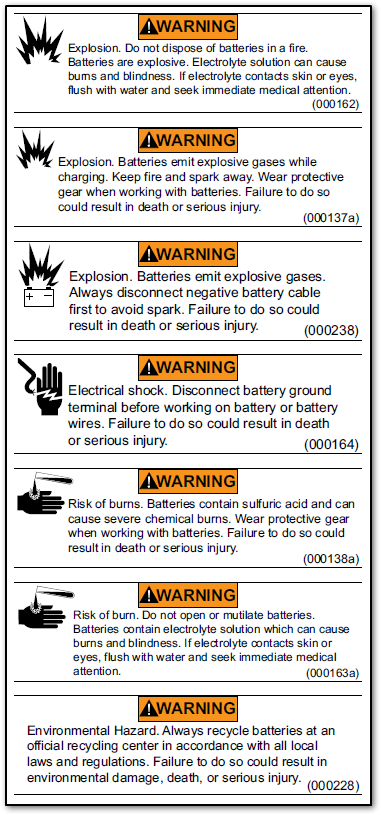Read the manual thoroughly and understand all of the instructions, cautions, and warnings before using this equipment. If any section of the manual is not understood, contact your nearest authorized dealer, or contact Generac Customer Service at 1-888-436-3722 (1-888-GENERAC), or www.generac.com with any questions or concerns.
Safety precautions and required tools for home standby battery maintenance, replacement, and testing
Safety is paramount when working with electrical systems and batteries. This article advises turning off the generator and disconnecting it from all power sources before beginning any work. It lists the required tools for battery maintenance and troubleshooting.
Following the right safety protocols and using the proper tools can help prevent accidents and injuries.
If you are uncertain about any aspect of the procedure, Generac recommends seeking assistance from an authorized Generac Service Dealer. See How Can I Find a Generac Service Dealer in My Area?

Environment
This article applies to Generac air-cooled home standby generators.
Preparing the generator for maintenance and troubleshooting
- Power Down: Ensure the generator is turned off, the 7.5 A fuse from the generator control panel is removed and disconnect the battery charge as directed. This prevents accidental startups, which could lead to injuries. See How Do I Inspect the Battery On My Home Standby Generator?
- Remove Jewelry: take off any metallic jewelry to avoid electrical conductivity risks.
- Check for Leaks: Before starting, inspect the battery for any signs of leakage or damage. If the battery is leaking, cracked, or damaged, it should be replaced immediately.
Safety Gear and Precautions
- Insulated Tools: Use tools with insulated handles to prevent accidental short circuits, which can cause sparks.
- Robber Gloves and Boots: wear rubber gloves and boots to insulate yourself from electrical shows and protect against acid spills.
- Eye Protection: Always wear safety goggles to protect your eyes from splashes of battery acid or other debris.
- Protective Clothing: Wear long sleeves and pants to protect your skin from acid spills. If electrolytes contact your skin, wash it off immediately with water.
- No smoking: Never smoke near a battery, as batteries emit hydrogen gas that can ignite.
- Avoid Sparks and Fire: Keep the battery area free from open flames, sparks, or anything that could ignite the hydrogen gas.
- Discharge Static Electricity: Touch a grounded metal object before handling the battery to discharge any static electricity accumulated in your body.
- Safe Storage of Tools: never place tools or metallic objects on top of the battery, as this can create a conductive path between the terminals, leading to short circuits or sparks.
Required Tools for Battery Maintenance
- Digital Multimeter: Essential for measuring voltage and checking the health of the battery.
- Insulated Wrenches: for safely tightening and loosing terminal connections.
- Wire Brush: for cleaning corrosion from battery terminals and connectors.
- Battery Terminal Protector: A spray or gel that helps prevent corrosion.
Precautions for Connecting and Disconnecting the Battery
- Correct order: When disconnecting the battery, remove the negative terminal first and then the positive. When reconnecting, attach the positive terminal first, followed by the negative. this reduces the risk of short circuits.
- No metal Contact: Ensure that your tools do not simultaneously touch the battery terminals and another metal surface, could create a short circuit.



